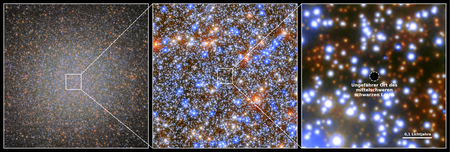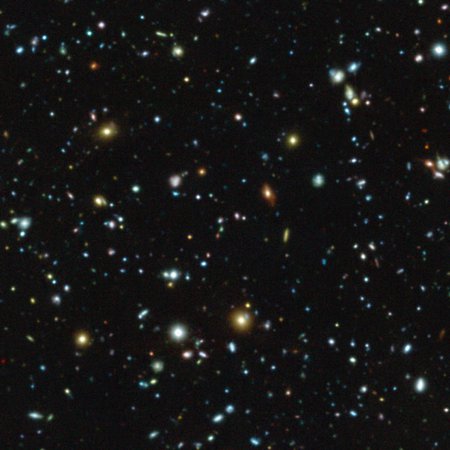First medium-sized black hole discovered in the centre of Omega Centauri

A view into the central region of the star cluster Omega Centauri, with images from the Hubble Space Telescope, shows on the right side the position of the intermediate-mass black hole. It was found by seven fast moving stars in its vicinity.
Credit: ESA/Hubble & NASA, M. Häberle (MPIA)Newly identified, extremely fast-moving stars in the star cluster Omega Centauri provide solid evidence for a black hole in its centre. With at least 8200 solar masses this is the first intermediate-mass black hole reliably observed to date. The discovery also confirms that Omega Centauri is the core of a dwarf galaxy that was swallowed up by the Milky Way billions of years ago. Without its outer stars, the galaxy's core has hardly evolved since then. The study was published in the journal Nature.
Omega Centauri is a spherical collection of about ten million stars, visible as a smudge in the night sky from Southern latitudes. Through small telescopes, the star cluster looks so dense towards the centre that it becomes impossible to distinguish individual stars. Now a new study led by Maximilian Häberle from the Max Planck Institute for Astronomy and with the participation of Dr. Nikolay Kacharov, scientist at the Leibniz-Institute for Astrophysics Potsdam (AIP), confirms what astronomers have suspected for some time: Omega Centauri contains a central black hole. With its mass, it represents also a kind of "missing link" between the small-mass stellar black holes and the giant supermassive black holes in the centres of large galaxies.
The current picture of galaxy evolution assumes that the earliest galaxies had medium-sized central black holes. In the course of time the galaxies grew by merging with larger galaxies or by incorporating smaller galaxies. During these processes, their central black holes also gained more mass. Therefore, medium-sized black holes are hard to find in today's universe. On the one hand, galaxies like our Milky Way have long "grown up" and contain significantly more massive central black holes. On the other hand, the smaller dwarf galaxies are generally more difficult to observe. With the currently available technology, the detection of black holes in their centres is extremely challenging. There have been promising candidates so far, but no definitive proof of an intermediate-mass black hole.
Omega Centauri is therefore something very special. As the nucleus of a former separate dwarf galaxy that merged with the Milky Way, losing all stars except those in the core region, Omega Centauri is “frozen in time”. With the loss of its outer stars, the evolution of the former dwarf galaxy was cut short, and the black hole in its centre no longer had the chance to grow.
Previous clues to a central black hole in Omega Centauri were based on large-scale models of the motion of stars in the cluster, but they left room for doubt. A new research project by Nadine Neumayer, group leader at the Max Planck Institute for Astronomy, and Anil Seth from the University of Utah to investigate the movements of stars aimed to better understand the history of Omega Centauri's formation and to detect a possible black hole, ideally through stars in the cluster’s centre that are moving particularly fast. Nikolay Kacharov, one of the co-initiators of the project, explains: “We expected that we would need to do a comprehensive dynamical modelling of the 3D motions of hundreds of thousands of stars that could potentially reveal the subtle gravitational signature of an intermediate-mass black hole. Finding fast moving stars close to the dark mass is hard - they could just not exist or be too faint to detect.”
Maximilian Häberle, a doctoral student at the Max Planck Institute for Astronomy, set about searching for such fast stars and compiled a huge catalog of the movements of the stars in Omega Centauri. Using over 500 archive images from the Hubble Space Telescope, he determined the velocities of 1.4 million stars. He found seven stars with high velocities moving in different directions in the central cluster region. They only allow one explanation: There is indeed a black hole with a mass of at least 8,200 solar masses in the centre of Omega Centauri. Häberle thus also provides the most reliable evidence to date of the existence of such intermediate-mass black holes as the missing link between stellar and supermassive black holes. At a distance of around 18,000 light years, this is even the nearest massive black hole to Earth, 9000 light-years closer than the supermassive black hole at the centre of the Milky Way.
Further information
Original publication:
M. Häberle et al. 2024: „Fast-moving stars around an intermediate-mass black hole in ω Centauri”, Nature, https://www.nature.com/articles/s41586-024-07511-z, DOI:10.1038/s41586-024-07511-z
Max-Planck Institute for Astronomy:
ESA News:
Images
A view into the central region of the star cluster Omega Centauri, with images from the Hubble Space Telescope, shows on the right side the position of the intermediate-mass black hole. It was found by seven fast moving stars in its vicinity.
Big screen size [1000 x 338, 810 KB]
Original size [3547 x 1199, 7.7 MB]



